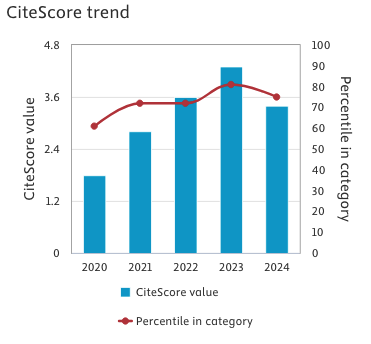Impact of the COVID-19 pandemic on pediatric bacterial infection rates: a population-based study
Keywords:
Immunity debt, Coronavirus disease, bacterial infection, COVID-19Abstract
Background and aim: During the COVID-19 pandemic a significant reduction of viral infections was observed in children probably due to the imposition of lockdown measures. The aim of this study was to compare the incidence of some common bacterial infections in children before and after COVID-19 pandemic in an Italian third-level pediatric hospital
Methods: We retrospectively reviewed medical records of patients evaluated at our Pediatric Clinic from October 2018 to April 2019 in comparison to those admitted from October 2022 to April 2023. All patients aged 0-16 hospitalized with a diagnosis of a bacterial infection were included in the analysis.
Results: A total of 879 children was enroled. The 2 groups were comparable in terms of age and sex. No significant difference emerged, except for the presence of a concomitant acute viral illness, less frequently found in 2022-2023 than in 2018-2019. The incidence of bacterial infections resulted significantly higher in 2022-2023 than in 2018-2019 with an estimated OR of 2.92 (95%CI 1.88-4.48).
Conclusions: The non-pharmacological measures adopted during the pandemic might have been a double-edged sword for young children, as delayed immune maturity might have increased susceptibility to infections and led to an increase in invasive bacterial infections.
References
1. Howard-Jones AR, Bowen AC, Danchin M, et al. COVID-19 in children: I. Epidemiology, prevention and indirect impacts. J Paediatr Child Health. 2022;58:39-45. doi: 10.1111/jpc.15791.
2. Britton PN, Koirala A, Wood N, Macartney K. COVID-19, children and schools: overlooked and at risk. Med J Aust. 2021;214:189- e1. doi: 10.5694/mja2.50938.
3. Martinez ME. The calendar of epidemics: Seasonal cycles of infectious diseases. PLoS Pathog. 2018;14:e1007327. doi: 0.1371/journal.ppat.1007327.
4. Viboud C, Bjornstad ON, Smith DL, Simonsen L, Miller MA, Grenfell BT. Synchrony, waves, and spatial hierarchies in the spread of influenza. Science. 2006;312:447-51. doi: 10.1126/science.1125237.
5. Baker RE, Yang W, Vecchi GA, Metcalf CJE, Grenfell BT. Susceptible supply limits the role of climate in the early SARS-CoV-2 pandemic. Science. 2020;369:315-9. doi: 10.1126/science.abc2535.
6. Grenfell BT, Bjornstad ON, Kappey J. Travelling waves and spatial hierarchies in measles epidemics. Nature. 2001;414:716-23. doi: 10.1038/414716°.
7. Becker AD, Wesolowski A, Bjornstad ON, Grenfell BT. Long-term dynamics of measles in London: Titrating the impact of wars, the 1918 pandemic, and vaccination. PLoS Comput Biol. 2019;15:e1007305. doi: 10.1371/journal.pcbi.1007305.
8. Liguoro I, Pilotto C, Vergine M, Pusiol A, Vidal E, Cogo P. The impact of COVID-19 on a tertiary care pediatric emergency department. Eur J Pediatr. 2021;180:1497-504. doi: 10.1007/s00431-020-03909-9.
9. Li Y, Guo Y, Duan Y. Changes in Streptococcus pneumoniae infection in children before and after the COVID-19 pandemic in Zhengzhou, China. J Infect. 2022;85:e80-e1. doi: 10.1016/j.jinf.2022.05.040.
10. Cohen R, Ashman M, Taha MK, et al. Pediatric Infectious Disease Group (GPIP) position paper on the immune debt of the COVID-19 pandemic in childhood, how can we fill the immunity gap? Infect Dis Now. 2021;51:418-23. doi: 10.1016/j.idnow.2021.05.004.
11. Danino D, van der Beek BA, Givon-Lavi N, Greenberg D, Ben-Shimol S, Dagan R. Unraveling the Impact of Pneumococcal Conjugate Vaccines on Ambulatory Antibiotic Drug Consumption in Young Children: An Interrupted Time-Series Analysis. Clin Infect Dis. 2021;73:1268-78. Doi: 10.1093/cid/ciab413.
12. Cohen PR, Rybak A, Werner A, et al. Trends in pediatric ambulatory community acquired infections before and during COVID-19 pandemic: A prospective multicentric surveillance study in France. Lancet Reg Health Eur. 2022;22:100497. doi: 10.1016/j.lanepe.2022.100497.
13. Hatter L, Eathorne A, Hills T, Bruce P, Beasley R. Respiratory syncytial virus: paying the immunity debt with interest. Lancet Child Adolesc Health. 2021;5:e44-e5. doi: 10.1016/S2352-4642(21)00333-3
14. Foley DA, Yeoh DK, Minney-Smith CA, et al. The Interseasonal Resurgence of Respiratory Syncytial Virus in Australian Children Following the Reduction of Coronavirus Disease 2019-Related Public Health Measures. Clin Infect Dis. 2021;73:e2829-e30. doi: 10.1093/cid/ciaa1906.
15. Chuang YC, Lin KP, Wang LA, Yeh TK, Liu PY. The Impact of the COVID-19 Pandemic on Respiratory Syncytial Virus Infection: A Narrative Review. Infect Drug Resist. 2023;16:661-75. doi: 10.2147/IDR.S396434.
16. Abu-Raya B, Reicherz F, Michalski C, et al. Loss of Respiratory Syncytial Virus Antibody Functions During the Peak of the COVID-19 Pandemic Mitigation Measures. J Pediatric Infect Dis Soc. 2023;12. doi: 10.1093/jpids/piad099.
17. Weinberger DM, Klugman KP, Steiner CA, Simonsen L, Viboud C. Association between respiratory syncytial virus activity and pneumococcal disease in infants: a time series analysis of US hospitalization data. PLoS Med. 2015;12:e1001776. doi: 10.1371/journal.pmed.1001776.
18. Greenberg D, Givon-Lavi N, Faingelernt Y, et al. Nasopharyngeal Pneumococcal Carriage During Childhood Community-Acquired Alveolar Pneumonia: Relationship Between Specific Serotypes and Coinfecting Viruses. J Infect Dis. 2017;215:1111-6. doi: 10.1093/infdis/jiw613
19. Weinberger DM, Harboe ZB, Viboud C, et al. Serotype-specific effect of influenza on adult invasive pneumococcal pneumonia. J Infect Dis. 2013;208:1274-80. doi: 10.1093/infdis/jit375.
20. Garancini N, Ricci G, Ghezzi M, et al. Invasive Group A streptococcal infections: are we facing a new outbreak? A case series with the experience of a single tertiary center. Ital J Pediatr. 2023;49:88. doi: 10.1186/s13052-023-01494-9.
21. Netea MG, Dominguez-Andres J, Barreiro LB, et al. Defining trained immunity and its role in health and disease. Nat Rev Immunol. 2020;20:375-88. doi: 10.1038/s41577-020-0285-6.
Downloads
Published
Issue
Section
License
Copyright (c) 2025 Chiara Pilotto, Giada Piccinin, Giorgia Tanzi, Giorgia Martini, Paola Cogo, Ilaria Liguoro

This work is licensed under a Creative Commons Attribution-NonCommercial 4.0 International License.
This is an Open Access article distributed under the terms of the Creative Commons Attribution License (https://creativecommons.org/licenses/by-nc/4.0) which permits unrestricted use, distribution, and reproduction in any medium, provided the original work is properly cited.
Transfer of Copyright and Permission to Reproduce Parts of Published Papers.
Authors retain the copyright for their published work. No formal permission will be required to reproduce parts (tables or illustrations) of published papers, provided the source is quoted appropriately and reproduction has no commercial intent. Reproductions with commercial intent will require written permission and payment of royalties.






